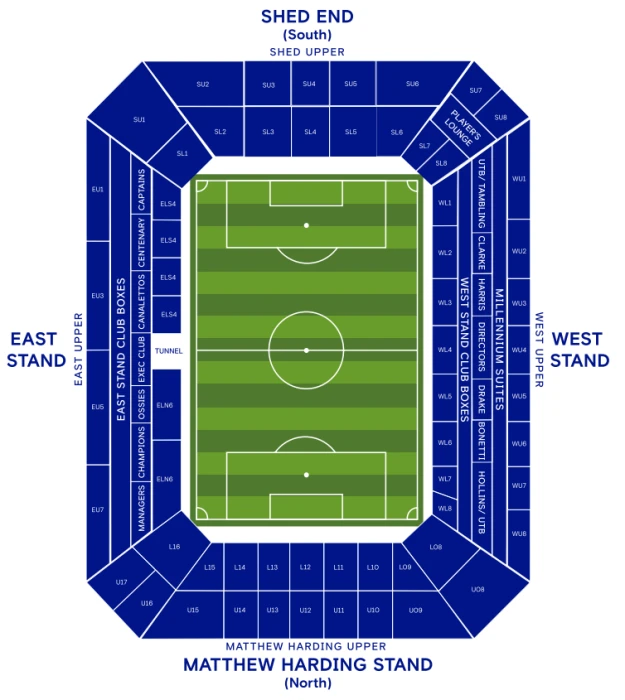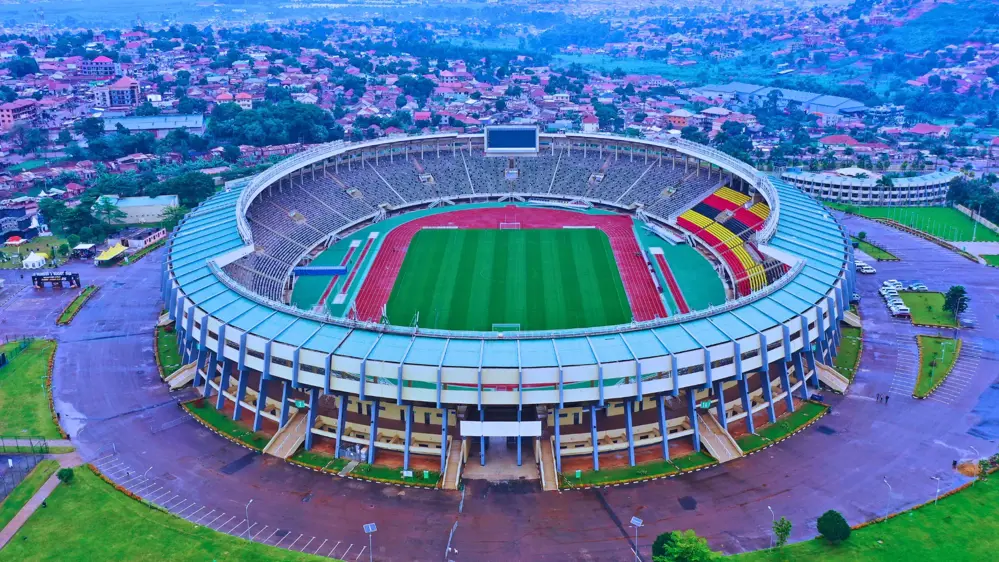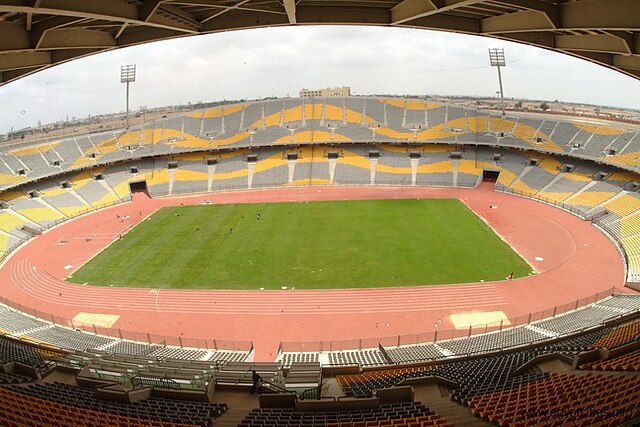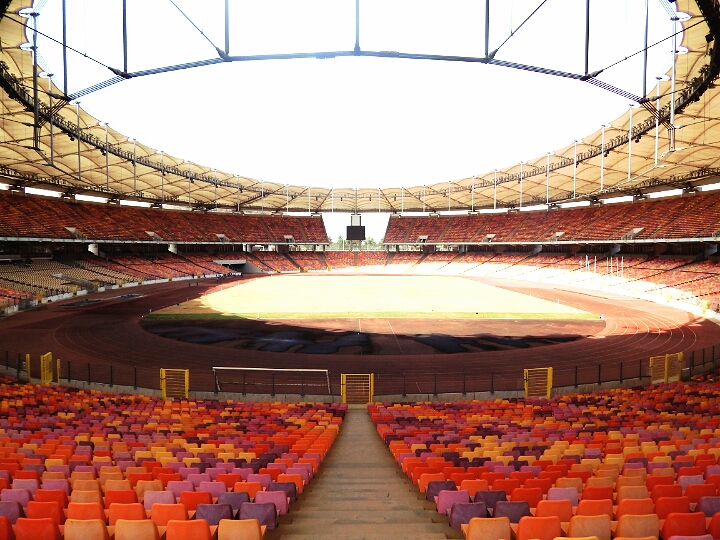Stamford Bridge Stadium Explained Details For You To Know

Welcome to the home of Chelsea F.C., Stamford Bridge Stadium! Whether you’re a die-hard fan or just visiting London, this stadium is a must-see destination.
With its rich history and impressive architecture, it’s no wonder that Stamford Bridge has become an iconic landmark in the city.
But there’s more to this stadium than meets the eye – from record-breaking attendance numbers to unique events hosted on-site, we’ll take you through all the details you need to know about Stamford Bridge Stadium. So grab your scarves and let’s dive into what makes this stadium so special!
Stamford Bridge Stadium Capacity
It has a seating capacity of 40,834 spectators. The stadium’s seating arrangement is designed to provide a great viewing experience for all spectators. Stamford Bridge boasts an impressive number of seats, making it one of the largest stadiums in London.
The current capacity was achieved after many years of renovations and expansions since its establishment in 1877. The most significant expansion to date took place in the early 2000s when additional tiers were added to three sides of the stadium.
The renovation work did not compromise on space between seats as ample legroom ensures that all fans are comfortable throughout their stay at the stadium. The club also provides VIP and corporate hospitality boxes that add up to over 1000 premium seats.
With such an impressive number of seats available, Stamford Bridge remains one of England’s biggest football clubs’ homes with hundreds more able to enjoy watching matches from standing areas.
Design and Architecture
Stamford Bridge Stadium, located in Fulham, London, is home to the popular football club Chelsea F.C. The stadium was first opened in 1877 and has since undergone numerous renovations and expansions to become the modern arena that it is today.
One of the most notable features of Stamford Bridge’s design and architecture is its distinct rectangular shape with four separate stands surrounding the pitch. The West Stand, which faces toward Fulham Broadway station, is the largest and includes executive suites, hospitality lounges, and restaurants for fans to enjoy before or after matches.
The East Stand houses Chelsea’s home supporters while away supporters are seated in the Shed End. The North Stand contains a mixture of seating areas for both home and away fans.
Over time, various upgrades have been made to increase fan comfort such as creating wider seats with more legroom as well as adding new amenities like food outlets throughout all four stands.
Despite these changes over time, however, Stamford Bridge still retains much of its original charm whilst also providing modern conveniences for match-goers.
Though, the design and architecture at Stamford Bridge Stadium remain one of a kind – featuring unique angles that provide excellent sightlines from every seat within this iconic ground!
The Matthew Harding Stand
Along the north side of the field stands the Matthew Harding Stand, previously known as North Stand. Constructed in 1939 as a small two-story seating area, its expansion was put on hold due to World War II and its aftermath.
In 1976, it was demolished and replaced by an open terracing area. Finally, in 1993, this terrace was closed off and renovated into the current two-tiered structure that is now called the Matthew Harding Stand.
Matthew Harding was a former Chelsea director whose investment in the team during the early 1990s completely turned it around. Sadly, he passed away in a helicopter accident on October 22, 1996.
His investment meant that the stand could be built and ready for the 1996–1997 season; it consists of two tiers and can accommodate most season ticket holders – generating a great atmosphere in the lower tier. Any intentions to expand would require demolishing both the Chelsea Health Club and Spa as well as the nearby Chelsea F.C. Museum.
Because some entrances are blocked by TV outside broadcast vehicles, this stand only holds a portion of the fans for some Champions League games.
The East Stand
Only the East Stand, which had 6,000 seats and a terraced enclosure when Stamford Bridge was converted into a football stadium in 1905, was covered.
As the first stage of the stadium’s extensive renovations, the stand was completely demolished in 1973. As a result of the club’s financial struggles, only the new stand was completed when it was opened at the start of the 1974-1975 season.
Since 1973, the East Stand at the stadium has undergone extensive renovations and modernization yet it still retains its three-tiered cantilevered form. Home to the tunnel, dugout, dressing rooms, conference room, press center, and audio-visual equipment, this is the hub of the stadium.
The middle tier is made up of executive suites, facilities, and clubs. While most of the stand was overhauled in the 90s, the upper tier remains unchanged; an excellent spot for fans to take in a game with one of the best views on offer.
During José Mourinho’s tenure as manager back in 2005–06, he asked that the family section be shifted to this area from what used to be known as Shed End which had served as away supporters’ quarters.
The Shed End (South)
The pitch’s southern edge is occupied by the Shed End. Named after its most vocal fans, in 1930 a new terrace was constructed there to welcome more standing spectators.
The stand remained until 1994 when all-seater stadiums became obligatory following the Hillsborough tragedy and the Taylor Report. In its place, a seated stand stands but goes by the same name – The Shed End.
For the 1997-98 season, the new stand had its opening. Supporter enthusiasm gathers in both the Shed End and Matthew Harding Stand, and the view from the upper tier is considered one of the best in the stadium.
The centenary museum and memorial wall, allowing fans’ loved ones to pay tribute to them late in life, can also be found in this area. Along the South side of the stadium, a portion of the original wall lining the Shed End terrace stands to date.
Recent decoration has introduced large images of Chelsea legends and lights on that side as well. Since 2005 away team fans are given 3,000 tickets at the East section or roughly half the capacity of the stand itself.
The West Stand
In 1964–1965, terracing on the west side of the stadium was removed and replaced with seated seating. Originally, the West Stand was built with rising rows of wooden tip-up seats on iron frames, but the very front rows were built with concrete benches known as “the Benches.”
After the old West Stand was destroyed in 1997, the current West Stand was constructed in its place. A row of executive boxes adorns the entire length of the stand, which has three levels.
The lower tier was completed and opened in 1998, but it wasn’t until 2001 that the entire stand was ready. Without Roman Abramovich’s involvement, the building of the stand may have caused a financial disaster which would have put Chelsea into administration. Ken Bates had taken out a £70 million Eurobond loan to finance the project, having agreed on some difficult repayment terms.
Once a supporter enters the stadium via Fulham Road, the imposing stand is their first sight. With the hospitality entrances – once named after former Chelsea players Nigel Spackman and David Speedie – on either side of the Main Entrance, it’s clear that this is an important area of Stamford Bridge.
The signage at these entrances was changed to show directions rather than player names in 2020. Often referred to as the ‘Great Hall’, it houses the largest concourse and annually hosts events such as the Chelsea Player of the Year ceremony.
Record Attendance
Stamford Bridge has been the home ground of Chelsea Football Club since its establishment in 1905. Over the years, it has witnessed some magnificent moments and created unforgettable memories for both players and supporters alike.
When it comes to record attendance at Stamford Bridge, the number that stands out is 82,905. This high turnout was recorded on October 12th, 1935 when Chelsea faced Arsenal in a First Division match. It’s worth noting that this figure remains an English football league record for a club ground.
The stadium had undergone significant development over time which affected its capacity; hence current seating capacity is slightly above 40,000 spectators. Despite being reduced by nearly half of what it once held, Stamford Bridge continues to attract millions of fans from all over the world who come to witness live matches or tour one of England’s most iconic stadiums.
To put this into perspective, Barcelona’s Camp Nou Stadium can hold up to almost double that amount with a capacity of around 99k people yet they have never beaten Stamford Bridge’s attendance record!
Pitch Dimensions
The dimensions of a football pitch are an integral part of the game, and Stamford Bridge is no exception. The pitch at Stamford Bridge measures 103 meters in length by 67 meters in width, meeting the regulations set forth by FIFA. This means that it is large enough to accommodate a full-sized professional match.
The size of the pitch at Stamford Bridge allows for exciting gameplay and plenty of room for players to showcase their skills. It also provides ample space for fans to watch from the stands without obstructing any views.
In addition, proper maintenance of the pitch ensures its longevity throughout the season. Chelsea F.C.’s ground staff takes great care in maintaining a high-quality playing surface, with regular watering and mowing to ensure optimal conditions.
While often overlooked by spectators, understanding the dimensions and maintenance practices of a football club’s pitch can greatly impact gameplay and contribute to an overall enjoyable experience for all involved.
The Stadium’s location and how to get there
Location of Stamford Bridge stadium
Location is key for any stadium, and Stamford Bridge is no exception. Situated in the bustling West London neighborhood of Fulham, Stamford Bridge’s location makes it easily accessible by public transportation or car.
The stadium is located on Fulham Road, a popular shopping destination with plenty of restaurants and cafes to visit before or after the game. This area of London has a rich history and culture that can be explored through local museums and galleries.
But location isn’t just about what’s nearby – it also plays a role in creating an atmosphere during game days. The surrounding streets are filled with fans decked out in blue chanting their support for Chelsea F.C., making for an exciting pre-game experience.
Stamford Bridge’s location adds to its charm as a historic football ground situated in one of London’s most vibrant neighborhoods.
Getting at the Stamford Bridge Stadium
By train, visitors will have to alight at either Fulham Broadway Station or West Brompton Station and walk for a few minutes to reach the stadium. Alternatively, one can take a bus that goes directly to Stamford Bridge Stadium.
Driving to the stadium might be a bit tricky due to congestion on match days, but it’s still an option for those who prefer driving themselves. However, parking spaces around the stadium are limited and expensive.
For those coming from outside London or overseas visitors arriving at Heathrow Airport, you can easily access Stamford Bridge via tube services which connect with key stations across London.
Getting into Stamford Bridge should not be too much trouble for anyone as long as they plan and consider alternative modes of transportation other than driving themselves if they want an easier time navigating their way through traffic during matches!
Chelsea F.C.’s history at the stadium
Stamford Bridge has been the home of Chelsea Football Club since 1905. The club’s history at this iconic stadium is nothing short of impressive. Over the years, Stamford Bridge has witnessed countless memorable moments that have gone down in football folklore.
Some of the most significant events include Chelsea’s first-ever league championship win in 1955 and their historic UEFA Champions League triumph on home soil in 2012. The stadium has also played host to numerous high-profile matches such as FA Cup finals, League Cup finals, and international fixtures.
Over the years, some legendary players have graced the hallowed turf at Stamford Bridge. From Peter Osgood to Frank Lampard, Didier Drogba to Eden Hazard – these players have left an indelible mark on the club’s rich history.
The atmosphere inside Stamford Bridge on matchdays is electric. With a capacity of over 40,000 fans, it is one of the most intimidating arenas for opposing teams to visit. The passion and loyalty shown by Chelsea supporters are unrivaled across Europe.
In recent times, there has been talk about a potential move away from Stamford Bridge to a larger venue elsewhere in London. However, for many fans and players alike, leaving this iconic stadium behind would be like severing ties with their past – something that they simply cannot bear to do!
Other uses for Stamford Bridge Stadium
Stamford Bridge may be most famously known as the home of Chelsea F.C., but it has also served many other purposes. Over the years, Stamford Bridge has hosted concerts and events such as boxing matches, ice skating shows, and even a circus. It has been used for community events such as charity runs and fairs.
Additionally, Stamford Bridge was chosen to host several games during the 2012 Summer Olympics in London. The stadium underwent renovations to prepare for this prestigious event.
Stamford Bridge is more than just a football stadium; it is an iconic landmark that holds significant historical value. Its unique design and architecture continue to attract visitors from all over the world. Whether you’re a fan of football or simply interested in exploring historic venues in London, a visit to Stamford Bridge should be on your list!
Other Stadiums Stories:
- Gtech Community Stadium Detailed Info About Stadium For Brentford
- Etihad Stadium Beyond Football: A Look at Its Hidden Gems and Features
- Inside Old Trafford: The Iconic Home of Manchester United and Its Impact on Football Culture
- Exploring Emirates Stadium: A Tour of the Iconic Home of Arsenal
- Legacy of Vitality Stadium: AFC Bournemouth’s Home Turf and Community Icon







3 Comments